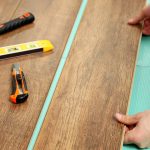The versatility of plastic pipes makes them an attractive option for many applications. And while plastic pipes are often used for underground drainage, you might wonder if you can pour concrete over them.
You can pour concrete over plastic pipes, but you should take certain precautions to ensure your structure is safe and secure. The plastic pipes should be firmly secured and surrounded by compacted gravel or sand to provide a solid foundation before pouring the concrete.
The rest of this article will discuss how to properly pour concrete over plastic pipes and the benefits of doing so. I’ll also provide tips on detecting water leaks on your plastic pipes.
Table of Contents
The Right Way to Pour Concrete Over Plastic Pipes
Pouring concrete over plastic pipes can be challenging, as the pipes can move or shift during the pour, and the concrete can cause them to crack. To ensure that your plastic pipes are adequately protected, it’s important to take certain precautions and follow the proper steps.
Here are the steps to take when pouring concrete over plastic pipes:
- Dig a trench to lay the pipe in. The trench should be wide and deep enough to accommodate the concrete mix and the pipe. You may need to use a shovel or trench to dig the trench.
- Prepare the trench where you will be pouring the concrete. The surface should be level and slightly slope away from the plastic pipe to prevent water from pooling around it. Remove any dirt or debris from the trench to ensure that the concrete has an excellent base to adhere to.
- Inspect the pipe for leaks. Cracks or holes in the pipe could cause serious problems with the concrete as it sets. Thoroughly inspect the pipe and repair any leaking or cracked areas to ensure it is watertight.
- Lay the pipe in the trench. You will need to lay the plastic pipe in the trench and secure it with straps or ties. Ensure the pipe is properly secured and won’t move during the pour.
- Cover the pipes with a protective layer. If the pipes are exposed, cover them with plastic wrap or other material that will act as an insulating barrier between the concrete and the pipes.
- Add a layer of sand or gravel. Spread a layer of sand or gravel over the pipes to provide additional protection. This will also help the concrete mix adhere better and reduce cracking. Gently tamp down the sand or gravel to secure it and ensure it is level.
- Mix the concrete according to the manufacturer’s instructions. Use the correct amount of water and mix the concrete thoroughly to ensure a consistent consistency. The concrete should be wet enough to move freely around the plastic pipe but dry enough to hold its shape when poured.
- Pour the mixed concrete around the pipes. Start at one end and slowly pour in a circular motion, ensuring that all areas are covered with an even layer of concrete. Use a shovel or trowel to spread the concrete evenly around the pipe and remove any air pockets while being careful not to disturb the pipe’s position.
- Continue to pour and spread the concrete until the desired depth is attained. Ensure that all areas are covered with a uniform layer of concrete and that the pipe is completely submerged in the concrete.
- Smooth the surface of the concrete. Use a trowel or float to even out the surface, paying extra attention to areas near the pipe. You can also add a decorative finish to the concrete if desired.
- Allow the poured concrete to cure and dry completely. During this time, keep the concrete moist and covered with a curing compound or damp burlap to slow evaporation and prevent cracking. This could take up to a week. Any heavy equipment or traffic should be avoided during the curing process.
Once the concrete has cured, you can remove the coverings and enjoy your newly poured structure. To ensure the long-term integrity of your plastic pipes, it’s important to follow these steps and take the necessary precautions. This will help protect them from damage and ensure they remain safe and secure for years.
Benefits of Pouring Concrete Over Plastic Pipes
Pouring concrete over plastic pipes can offer several benefits.
- Durability: Concrete provides a strong, durable base for the pipes, protecting them from external elements and helping to prevent cracking or leaking. This can help extend the life of the pipes and prevent potential problems from occurring.
- Protection: The concrete layer acts as an extra layer of protection for the plastic pipes, shielding them from extreme temperatures and pressure that could cause them to become damaged over time.
- Cost: Pouring concrete over plastic pipes is a cost-effective way to protect and secure them and provide a solid base for the pipes. This can save money in the long run by helping to prevent costly repairs or replacements.
- Compatibility: Concrete is compatible with most plastic pipes, making it an ideal choice for various applications. This ensures that the pipes can be securely held in place, reducing the chances of them shifting or damaging.
- Customization. The concrete can easily be customized and finished for a more attractive look, adding to the overall aesthetic value of the structure. Moreover, it can also be painted or textured to help protect it from extreme weather and other conditions.
Detecting Water Leaks in Concrete Pipes
While pouring concrete over plastic pipes is a great way to protect them, it’s also important to be aware of any water leaks that may occur. You can use several methods to detect water leaks in concrete pipes.
- Visual inspection. You can inspect the trench and pipe visually for signs of water leaks. Look for any wet spots or dampness around the pipe, which could indicate a leak. Additionally, you can look for any discoloration, puddles, or concrete cracks that could signify a water leak.
- Pressure testing. A pressure test is another way to detect water leaks in concrete pipes. This test involves pressurizing a closed system and measuring the pressure drop over time. If the pressure drops rapidly, there is likely a water leak in the pipe or surrounding structure.
- Tracer gas. This method involves introducing a tracer gas into the system and looking for any traces outside of the structure. If any is found, it means there is a water leak present. This method is especially useful for detecting underground water leaks that may not be visible to the eye.
- Unusual noise. If you cannot detect a water leak using any of the above methods, try listening to unusual noises from your pipe system. Listen closely near the pipes and look for any strange noises, such as gurgling, bubbling, or hissing. This could indicate that there is a water leak in the pipe.
- Check for mold growth. If water is leaking from the pipe and coming into contact with nearby surfaces, then it’s possible that mold can start to form. Find discolored or musty-smelling surfaces near the pipes to detect mold growth. If you find mold, it’s important to act quickly to prevent it from spreading and causing further damage.
- Skyrocketing water bills. Leaks in concrete pipes can lead to an increase in water usage and a higher water bill. If you have noticed a sudden spike in your water bill, this could indicate a water leak in your pipe system.
Conclusion
Pouring concrete over plastic pipes is a great way to protect them from extreme temperatures and pressure and provide a solid base for the pipes. While it is a cost-effective solution, it’s important to be aware of the possibility of water leaks and have methods to detect them.



